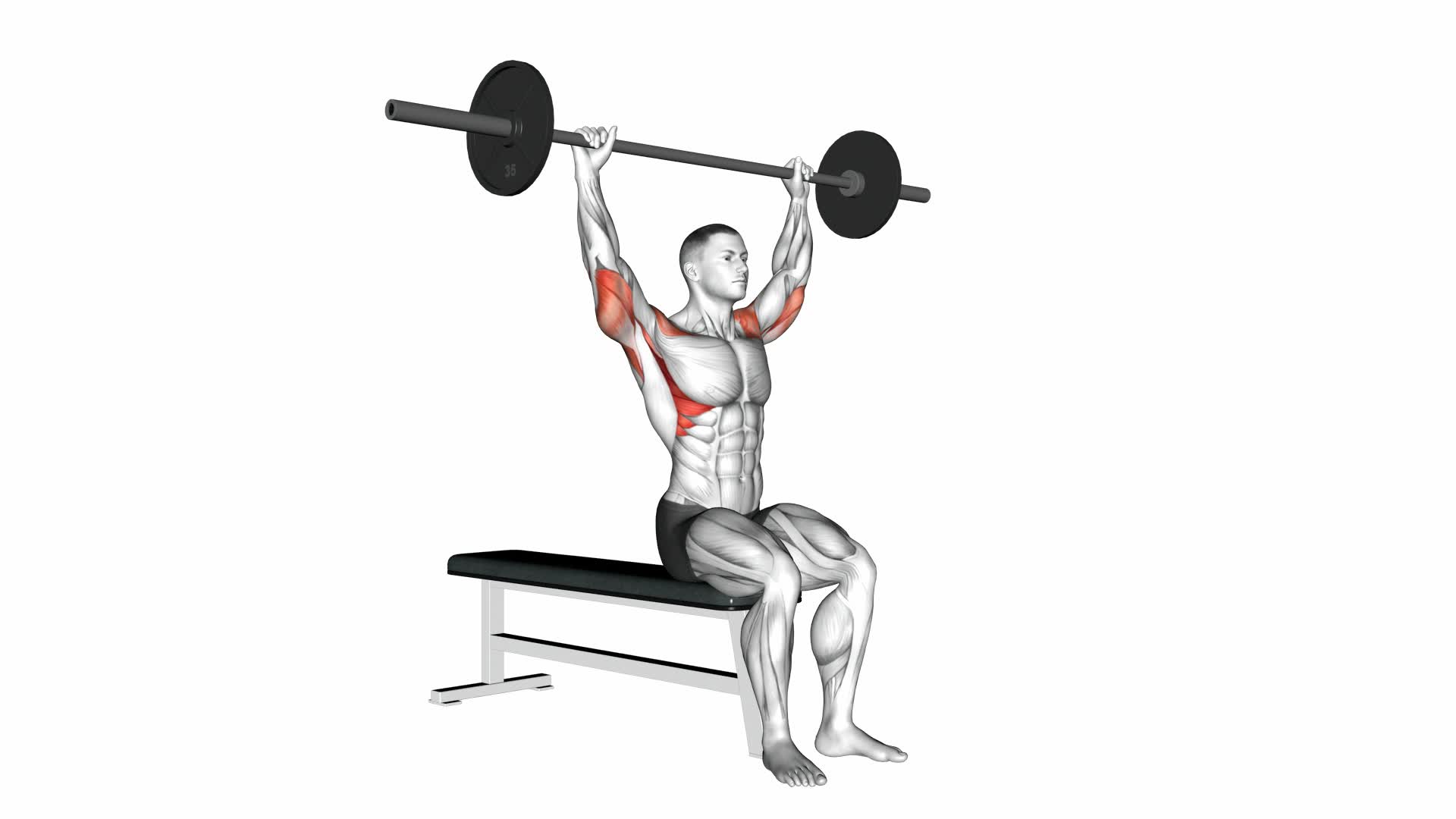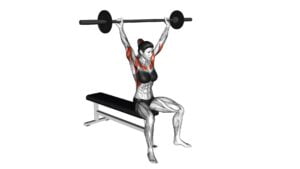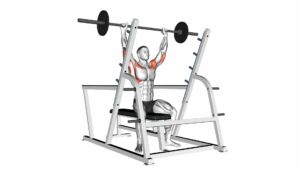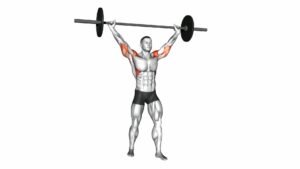Barbell Seated Behind Head Military Press – Video Exercise Guide & Tips

Looking to strengthen your shoulder muscles and improve your upper body strength? The Barbell Seated Behind Head Military Press is a challenging exercise that can help you achieve your goals.
Watch This Exercise Video
In this video exercise guide, we'll walk you through the proper form and technique, offer variations for different fitness levels, and provide tips to avoid common mistakes.
Watch the video, follow our tips, and get ready to see improvements in your strength and muscle gains. Let's get started!
Key Takeaways
- The barbell seated behind head military press increases stability and mobility of shoulder joints.
- Proper form and technique, as well as gradually increasing load, are crucial for safety during this exercise.
- The exercise targets deltoid, triceps, and upper back muscles, enhancing overall upper body strength.
- Modifications and variations, such as using dumbbells or incorporating plyometric movements, can be made to customize the exercise for different fitness levels.
Benefits of the Barbell Seated Behind Head Military Press
You can experience significant gains in shoulder and upper body strength by incorporating the barbell seated behind head military press into your workout routine. This exercise targets the deltoid muscles in your shoulders, as well as the triceps and upper back muscles. The benefits of this exercise are numerous.
Firstly, it helps to increase the stability and mobility of your shoulder joints, reducing the risk of injury during other exercises or daily activities. Additionally, the barbell seated behind head military press improves your posture and helps to correct imbalances between different muscle groups in your upper body. It also enhances your overall upper body strength, allowing you to lift heavier weights and perform other exercises more effectively.
While performing the barbell seated behind head military press, it's important to follow some safety precautions. Make sure to warm up properly before starting the exercise to prevent any muscle strains or injuries. Start with lighter weights and gradually increase the load as you become more comfortable with the movement. Keep your core engaged and maintain a neutral spine throughout the exercise to protect your lower back. It's also crucial to use proper form and technique, which will be discussed in the subsequent section.
Transition: Now that you understand the benefits and safety precautions of the barbell seated behind head military press, let's delve into the proper form and technique for this exercise.
Proper Form and Technique for the Exercise
To perform the barbell seated behind head military press with proper form and technique, focus on maintaining a neutral spine and engaging your core throughout the exercise. This will help you maximize the effectiveness of the exercise and avoid potential injuries.
Here are some key tips to ensure proper form and technique:
- Start by sitting on a bench with your feet flat on the floor and your back firmly against the bench. Grip the barbell with an overhand grip, slightly wider than shoulder-width apart.
- Lift the barbell off the rack and bring it to shoulder level, keeping your elbows slightly in front of the barbell. This is your starting position.
- Inhale, brace your core, and press the barbell overhead by extending your arms. As you press, ensure that the barbell moves in a straight line directly above your head. Exhale at the top of the movement and hold for a moment before slowly lowering the barbell back to the starting position.
Common mistakes to avoid include arching your back, leaning too far back, or using excessive momentum. These errors can decrease the effectiveness of the exercise and increase the risk of injury.
Variations and Modifications for Different Fitness Levels
Now that you have mastered the proper form and technique for the Barbell Seated Behind Head Military Press, it's time to explore variations and modifications to suit different fitness levels.
If you're a beginner, there are beginner-friendly modifications available to help you gradually build strength and improve your form.
For those at the advanced level, there are variations that can challenge you further and target specific muscle groups.
Beginner-Friendly Modifications
Modifying the barbell seated behind head military press can accommodate different fitness levels. For beginners or those with limited shoulder mobility, there are several modifications that can be made to ensure safety and effectiveness:
- Dumbbell Seated Press: Instead of using a barbell, start with dumbbells. This allows for greater range of motion and reduces strain on the shoulders.
- Seated Arnold Press: This variation involves rotating the palms during the press, which helps to engage more muscles and reduces stress on the shoulders.
- Seated Neutral Grip Press: Using a neutral grip, where the palms face each other, can help alleviate shoulder discomfort and provide a more comfortable pressing position.
Advanced Level Variations
For advanced level variations of the barbell seated behind head military press, consider incorporating plyometric movements to enhance power and explosiveness in your shoulder workout. Plyometric exercises involve quick and explosive movements, which can help improve your overall strength and athletic performance.
One advanced level progression you can try is the plyometric barbell seated behind head military press. Begin by performing the standard barbell seated behind head military press, but instead of pressing the barbell straight up, explosively push the barbell up and catch it at the top position with a slight bend in your elbows.
This movement requires a high level of strength and coordination, so make sure you have mastered the basic barbell seated behind head military press before attempting this advanced variation.
Incorporating advanced training techniques like plyometric movements can take your shoulder workout to the next level and help you achieve your fitness goals.
Customizing for Individual Needs
To tailor the barbell seated behind head military press to your individual needs, you can make variations and modifications based on your fitness level. This allows you to customize the exercise and achieve optimal results while considering any limitations or injuries you may have.
Here are three ways to modify the barbell seated behind head military press:
- Modifying for injuries: If you have shoulder or neck issues, you can replace the barbell with dumbbells or resistance bands. This reduces the strain on your joints while still targeting your shoulder muscles effectively.
- Personalized workout plans: Depending on your fitness level, you can adjust the weight, repetitions, and sets to match your capabilities. Gradually increase the intensity as you progress to avoid overexertion and maximize your gains.
- Incorporate other exercises: To further customize your workout, you can include supplementary exercises such as lateral raises, front raises, or shoulder shrugs. These exercises target different areas of your shoulders, providing a well-rounded shoulder workout.
Common Mistakes to Avoid While Performing the Exercise
When performing the barbell seated behind head military press, it's important to avoid certain common mistakes.
First, make sure your elbows aren't too wide, as this can put unnecessary strain on your shoulders.
Additionally, pay attention to your grip position to ensure it's correct.
Elbows Too Wide
You should avoid having your elbows too wide while performing the Barbell Seated Behind Head Military Press. When your elbows are too wide, it can negatively impact your shoulder mobility and lead to incorrect form.
Here are three reasons why you should keep your elbows in the correct position:
- Improved Stability: Keeping your elbows in a narrower position helps maintain stability throughout the movement, reducing the risk of injury.
- Increased Range of Motion: By keeping your elbows closer to your body, you can achieve a greater range of motion, allowing for a more effective shoulder press.
- Better Muscle Activation: Proper elbow positioning ensures that the target muscles, such as the deltoids and triceps, are activated optimally, leading to better muscle development.
By avoiding wide elbows, you can perform the Barbell Seated Behind Head Military Press with correct form and maximize the benefits of this exercise.
Now, let's move on to the next common mistake: incorrect grip position.
Incorrect Grip Position
Maintain a proper grip position to ensure correct form and maximize the benefits of the Barbell Seated Behind Head Military Press.
Your grip strength plays a crucial role in this exercise, as it helps you control the barbell and maintain stability throughout the movement.
When gripping the barbell, make sure your hands are slightly wider than shoulder-width apart. This will allow you to exert more force and engage your shoulder muscles effectively.
Additionally, a correct grip position is essential for proper shoulder mobility. By gripping the barbell correctly, you can avoid unnecessary strain on your wrists and elbows.
Remember to keep a firm but comfortable grip, and avoid over-gripping, as it can restrict blood flow and compromise your performance.
Lack of Shoulder Stability
To ensure proper form and prevent common mistakes, focus on maintaining shoulder stability while performing the Barbell Seated Behind Head Military Press. Lack of shoulder stability can lead to injuries and limit the effectiveness of the exercise.
Here are three key tips to improve shoulder stability:
- Warm up and stretch: Prioritize shoulder mobility exercises to increase range of motion and prepare the joints for the press. Incorporate exercises like shoulder circles, arm swings, and shoulder dislocations.
- Engage your core: A strong core plays a crucial role in maintaining shoulder stability. Brace your abs and keep your back straight throughout the exercise to stabilize your upper body.
- Start with lighter weights: Gradually increase the weight as your shoulder stability improves. This will help you maintain control and proper form, reducing the risk of injury.
Tips for Increasing Strength and Muscle Gains
To increase your strength and muscle gains, focus on incorporating progressive overload into your training routine. Progressive overload refers to gradually increasing the demands placed on your muscles over time, forcing them to adapt and grow stronger. One effective way to achieve progressive overload is by progressively increasing the amount of weight you lift during your strength training exercises. This can be done by adding small increments of weight each week or increasing the number of repetitions you perform.
In addition to progressive overload, there are other techniques you can incorporate to increase muscle mass and strength. One such technique is compound exercises, which involve multiple muscle groups and joints working together. Examples of compound exercises include squats, deadlifts, and bench presses. These exercises engage a larger number of muscle fibers, leading to greater gains in strength and muscle mass.
Another important aspect to consider is proper form and technique. Focus on maintaining good posture and performing each exercise with control and precision. This will ensure that you're effectively targeting the intended muscles and minimizing the risk of injury.
Lastly, prioritize rest and recovery. Adequate rest between workouts allows your muscles to repair and grow stronger. Aim for at least 48 hours of rest between strength training sessions, and make sure to get enough sleep to support muscle growth.
Safety Precautions and Injury Prevention Tips
Ensure proper form and minimize the risk of injury by following these safety precautions and injury prevention tips:
- Warm up properly: Before starting any exercise, it's crucial to warm up your muscles and joints. This helps increase blood flow and flexibility, reducing the risk of injury.
- Start with lighter weights: When performing the barbell seated behind head military press, start with lighter weights to allow your body to adapt to the movement. Gradually increase the weight as you become more comfortable and confident.
- Use a spotter: It's recommended to have a spotter when performing this exercise, especially if you're lifting heavy weights. A spotter can provide assistance and ensure your safety in case you're unable to complete a repetition.
Exercise safety and injury prevention should always be a top priority. By following these precautions, you can minimize the risk of injury and maximize the benefits of the barbell seated behind head military press. Remember to listen to your body, start slowly, and progress gradually to avoid unnecessary strain and injury.
Frequently Asked Questions
How Many Repetitions and Sets Should I Do When Performing the Barbell Seated Behind Head Military Press?
To find the optimal weight and progression for the barbell seated behind head military press, consider your current strength level and goals.
Start with a weight that challenges you but allows you to maintain proper form. Gradually increase the weight as you get stronger.
It's important to avoid common mistakes like arching your back or using momentum to lift the barbell. Focus on using your shoulder muscles to control the movement and prevent injury.
Can I Perform the Barbell Seated Behind Head Military Press With Dumbbells Instead of a Barbell?
Yes, you can perform the barbell seated behind head military press with dumbbells instead of a barbell. However, it's important to maintain proper form to prevent injury.
Make sure to sit upright, engage your core, and keep your elbows slightly in front of your body. Start with lighter weights to ensure control and stability, gradually increasing the weight as you become more comfortable.
Remember to always consult a professional before attempting any new exercises.
Is It Necessary to Warm up Before Attempting the Barbell Seated Behind Head Military Press?
It is absolutely necessary to warm up before attempting the barbell seated behind head military press. Warming up helps to prepare your muscles and joints for the exercise, reducing the risk of injury. It also increases blood flow and oxygen to the muscles, improving their performance.
There are different variations of the barbell seated behind head military press, including using dumbbells instead of a barbell. These variations can provide additional challenges and target different muscle groups.
Can I Incorporate This Exercise Into My Shoulder Workout Routine or Should I Do It Separately?
To incorporate the barbell seated behind head military press into your shoulder workout routine or to do it separately depends on your goals and preferences.
This exercise targets the deltoids and triceps, providing strength and size gains.
If you want to focus solely on shoulder development, it can be done as part of your routine.
However, if you're incorporating other shoulder exercises and prefer to isolate the movement, it can be done separately for better concentration and form.
What Are Some Alternative Exercises That Target the Same Muscles as the Barbell Seated Behind Head Military Press?
Looking for alternative exercises that target the same muscles as the barbell seated behind head military press? There are a few options you can consider.
One alternative is the dumbbell shoulder press, which also engages the shoulder muscles.
Another option is the seated Arnold press, which targets the deltoids as well.
Additionally, the standing military press can be a good alternative exercise for targeting the shoulder muscles.
Remember to consult a fitness professional to ensure proper form and technique.
Conclusion
In conclusion, the barbell seated behind head military press is a highly effective exercise for increasing upper body strength and muscle gains. By following proper form and technique, individuals can target their shoulder muscles and improve overall stability.
It's important to avoid common mistakes and take safety precautions to prevent injuries. With variations available for different fitness levels, this exercise can be tailored to individual goals and fitness levels.
Incorporating the barbell seated behind head military press into your workout routine can lead to impressive results.

Author
Years ago, the spark of my life’s passion ignited in my mind the moment I stepped into the local gym for the first time. The inaugural bead of perspiration, the initial endeavor, the very first surge of endorphins, and a sense of pride that washed over me post-workout marked the beginning of my deep-seated interest in strength sports, fitness, and sports nutrition. This very curiosity blossomed rapidly into a profound fascination, propelling me to earn a Master’s degree in Physical Education from the Academy of Physical Education in Krakow, followed by a Sports Manager diploma from the Jagiellonian University. My journey of growth led me to gain more specialized qualifications, such as being a certified personal trainer with a focus on sports dietetics, a lifeguard, and an instructor for wellness and corrective gymnastics. Theoretical knowledge paired seamlessly with practical experience, reinforcing my belief that the transformation of individuals under my guidance was also a reflection of my personal growth. This belief holds true even today. Each day, I strive to push the boundaries and explore new realms. These realms gently elevate me to greater heights. The unique combination of passion for my field and the continuous quest for growth fuels my drive to break new ground.







